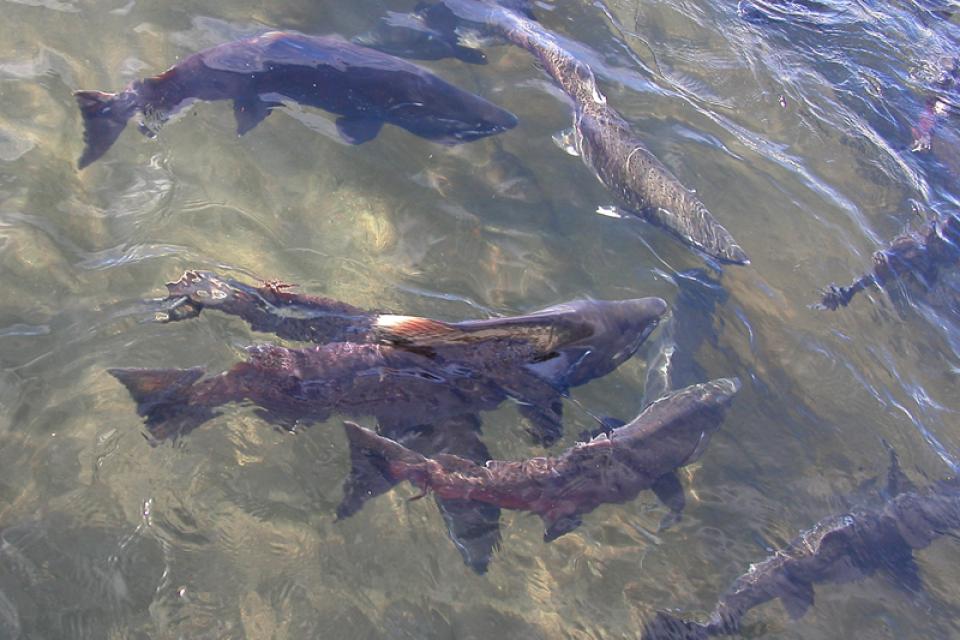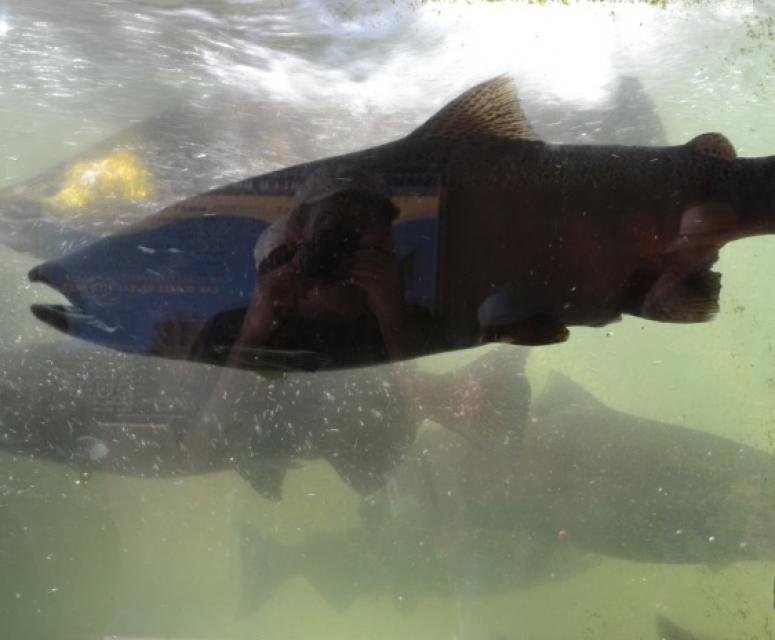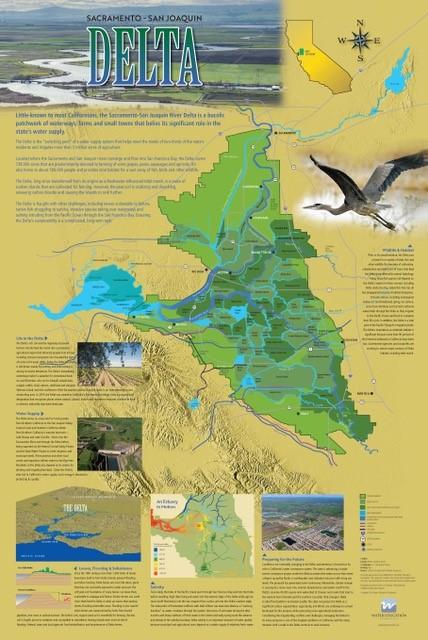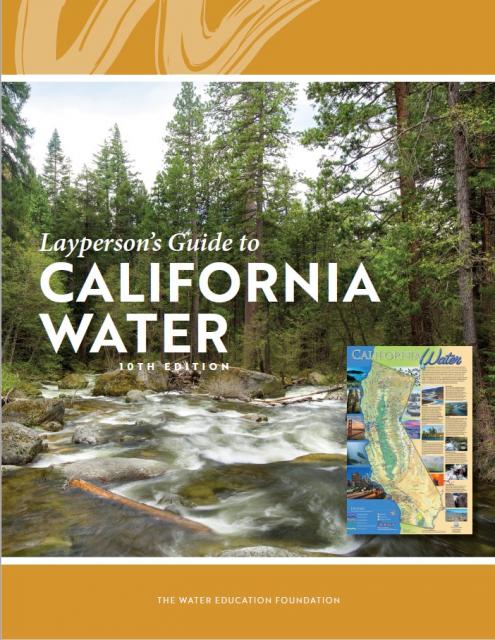Anadromous Fish
 Anadromous fish are freshwater fish
that migrate to sea and then return to spawn in fresh water.
Anadromous fish are freshwater fish
that migrate to sea and then return to spawn in fresh water.
In California, anadromous fish include coho salmon, chinook salmon and steelhead. Those inhabiting rivers across the Central Valley have experienced significant declines from historical populations. This is due to drought, habitat destruction, water diversions, migratory obstacles such as dams, unfavorable ocean conditions, pollution and introduced predator species.
The Sacramento River supports several runs of chinook salmon and steelhead. Sacramento River winter-run chinook have a unique migration schedule, spawning in the upper mainstem Sacramento River from mid-April through August, peaking in June and July. As such, the fish need cold, clean water that protect embryos and juveniles.
As many as 100,000 winter-run chinook returned to the river in the 1960s, according to the U.S. Fish and Wildlife Service. The species’ population declined in subsequent decades to just 186 in 1993. It was listed as endangered under the California Endangered Species Act in 1989 and under the federal Endangered Species Act in 1994.
Chinook salmon are important because they support commercial fishing and related jobs and economic activities at fish hatcheries.
Because of the many adverse conditions affecting anadromous fish populations, extensive research, funding and construction activities have been directed throughout California toward improving the ability of fish to successfully migrate to and from their spawning grounds.
Climate change is expected to affect the vitality of anadromous fish. Scientists with National Marine Fisheries Service (NMFS) in 2019 reported that warming temperatures are pushing four important populations, including chinook, toward extinction. Those that spawn far inland after lengthy summer stream migrations and those that spend a lot of time in coastal habitats like river estuaries are among those most at risk, according to NMFS.
These populations will need help to survive the warmer waters, more acidic oceans and changed seasonal streamflow patterns caused by global warming and other human impacts, NMFS said.
Extreme drought conditions in 2021 elevated temperatures in the Sacramento River, raising the risk that nearly all winter-run chinook juveniles in the river could die, according to the California Department of Fish and Wildlife. That, some believe, could put the future of the species in peril.
Agencies are taking extra steps to help the fish. In April 2021, the Department of Fish and Wildlife announced it would haul millions of juvenile fall-run, hatchery-raised chinook salmon from four Central Valley hatcheries to San Francisco, San Pablo, Half Moon and Monterey bay waters as a pre-emptive move to keep them away from overly warm river waters.
California wildlife officials took an unusual step to boost salmon by releasing millions of hatchery-raised Chinook salmon directly into the Sacramento River in April 2025. The move came on the heels of a decision earlier that month by the Pacific Fishery Management Council to cancel California’s commercial salmon fishing season for a third-straight year.
Anadromous Fish Restoration
The Anadromous Fish Restoration Program (AFRP), a part of the Central Valley Project Improvement Act, aims to double the natural production of fish that migrate between fresh water and salt water. Operations of the CVP, which includes 20 dams and reservoirs, have impaired the ability of fish to reach their spawning grounds in the Central Valley. The restoration program’s goal is to boost the numbers of salmon, steelhead, striped bass, American shad, white sturgeon and green sturgeon to at least twice the average levels attained during the period of 1967-1991.
Since 1995, AFRP has implemented more than 195 projects through funding by Congressional appropriations and a surcharge imposed on Central Valley Project water and power contractors.
The AFRP has also developed priorities based on the watershed’s capacity to increase fish production. These priorities include:
- improving habitat by removing artificial barriers to migration
- installing or upgrading fish ladders
- expanding and improving the quality of spawning grounds
- acquiring permanent easements in floodplains and riparian corridors
 Even so, anadromous fish populations
continue to struggle for survival. Most notably, the West Coast
salmon fishery collapsed in 2008. With the fish plummeting to
record low numbers, federal officials closed all commercial and
sport fishing off the coast of California and most of Oregon for
a time, though recent good years have resulted in the reopening
of such fishing.
Even so, anadromous fish populations
continue to struggle for survival. Most notably, the West Coast
salmon fishery collapsed in 2008. With the fish plummeting to
record low numbers, federal officials closed all commercial and
sport fishing off the coast of California and most of Oregon for
a time, though recent good years have resulted in the reopening
of such fishing.
In 2016 the NMFS included the winter-run chinook salmon as one of eight “Species in the Spotlight” among the most at risk for extinction in the near future. As such, establishing additional populations is vital to their survival.
The north fork of Battle Creek in Shasta County is historic habitat for winter-run chinook salmon. NMFS, the Bureau of Reclamation, state fisheries agencies and Pacific Gas and Electric Company have spent more than $100 million since 1999 to restore about 48 miles of prime salmon and steelhead habitat. More than 200,000 juvenile salmon were released in 2018 to boost the populations numbers after the harsh effects of the severe drought in 2014 and 2015.
In 2020, six agencies from the state of California and the federal government and the Sacramento River Settlement Contractors signed the Sacramento River Science Partnership. The intent is to develop an interagency science collaborative to share and discuss science to inform needed protection of the four runs of Sacramento River chinook salmon.










